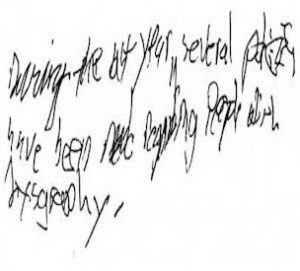In honor of Learning Disabilities Awareness Month, we are happy to share with you a few posts about some common learning disabilities and how you can better understand the children (and parents) who struggle with these disorders. Today’s post comes to us from our friends at The Children’s Center for Therapy.
 Dysgraphia is one of many learning disorders that is misunderstood, and often unheard of among many parents, teachers, and even medical professionals. Dysgraphia by Latin definition means difficulty writing. Dys=difficult, graphia= to write. It seems simple, but there is much more behind this word than meets the eye. Children (and adults!) with dysgraphia can have problems with spelling, handwriting, and putting thoughts onto paper. Writing is a very complex process when you think about it: coming up with the idea of what to write, holding a pencil correctly so that you may form letters legibly, having the eye-hand coordination necessary to fit letters between the 2 lines on the paper, spacing words and letters accurately, spelling words correctly, adding correct punctuation, and utilizing correct grammar. However, with technological advances, and the push for schools to teach more curriculum based topics, handwriting often gets pushed to the wayside and much of this work has been taken off our hands.
Dysgraphia is one of many learning disorders that is misunderstood, and often unheard of among many parents, teachers, and even medical professionals. Dysgraphia by Latin definition means difficulty writing. Dys=difficult, graphia= to write. It seems simple, but there is much more behind this word than meets the eye. Children (and adults!) with dysgraphia can have problems with spelling, handwriting, and putting thoughts onto paper. Writing is a very complex process when you think about it: coming up with the idea of what to write, holding a pencil correctly so that you may form letters legibly, having the eye-hand coordination necessary to fit letters between the 2 lines on the paper, spacing words and letters accurately, spelling words correctly, adding correct punctuation, and utilizing correct grammar. However, with technological advances, and the push for schools to teach more curriculum based topics, handwriting often gets pushed to the wayside and much of this work has been taken off our hands.

So why is it so important for our children to write, you ask? The link between writing and reading is profound, along with small hand muscle development, cognitive development, social interaction, and completing basic activities of life. Can you imagine not passing notes to your best friend during class in middle school? Or not being able to read that special hand written (in cursive) letter sent to you from your Grandma in the mail? How about not being able to sign your name, write a check, or make a grocery list? Handwriting is essential to our everyday lives.
Dysgraphia is not just sloppy handwriting. It is a brain-based learning disorder resulting from visual-spatial deficits (trouble processing what the eye sees), and language processing difficulties (trouble processing and making sense of what the ear hears). It is a lifelong challenge, however can be improved over time with practice, accommodations, and modifications. It is extremely important for teachers and parents to request evaluation and intervention as early as possible if he or she suspects a child may have dysgraphia. Here are some “red flags” for dysgraphia based on age:
| YOUNG CHILDREN | SCHOOL-AGED CHILDREN | TEENS AND ADULTS |
|
|
So, what can we do to assist a child with dysgraphia in being successful with handwriting tasks? The first step is to be evaluated by a medical professional (psychologist, occupational therapist, speech therapist). Based on the evaluation, a treatment plan and recommendations will be given to assist the child with their specific writing difficulties. Each child’s plan and recommendations will be different based on the child’s needs, but in general there are 3 categories of recommendations:
- Accommodation (providing alternatives to writing)
- Modification (changing the task expectations and/or demands)
- Remediation (instruction/practicing handwriting).
Here are the very general recommendations I personally give to parents and teachers by category:
| Accommodate | Modify | Remediate |
|
|
As always, the most important key to success with dysgraphia, or any deficit, is parent and teacher involvement. You must spend time practicing handwriting tasks with your child and making them fun so they are engaged and do not view writing as a negative experience. The most success and learning will come from completing activities that do not feel or look, like work. Monotonous busy-work with copying and tracing letters can be helpful but will take much longer to see improvement in your child’s performance as compared to utilizing a multi-sensory, play-based approach. Reward children for their work, and praise them for what looks like a small gain to you, but is HUGE for them.
A special thank you to The Children’s Center for Therapy for their words of wisdom today. Stay tuned for another post from CCFT, dealing with dyslexia.











I likewise conceive thus, perfectly written post! .
nike sb shoes
[url=http://www.cookingholidayspain.com/2630-1451.html]nike sb shoes[/url]